If so, it's on Argentina's part. The Brazilian acquisition of the former HMS Vengeance, just like the acquisition of the dreadnoughts 50 years before, was mostly driven by internal Brazilian politics. The main reasons for the purchase were president Juscelino Kubitschek wanted: 1) to keep the Navy happy to make it less coup-prone; 2) the Air Force fighting the Navy instead of trying to oust him from power(there were two barracks revolts by the Air Force at the time, one shortly before he assumed office, the other during his administration) - he succeeded in having the two fight each other, but the fighting only happened after his administration.The timing of the sales to first Brazil and then Argentina is amusing. An attempt at oneupmanship leading to the balance of power being restored?
You are using an out of date browser. It may not display this or other websites correctly.
You should upgrade or use an alternative browser.
You should upgrade or use an alternative browser.
More Colossus / Majestics for other navies ?
- Thread starter Archibald
- Start date
- Joined
- 27 September 2006
- Messages
- 5,744
- Reaction score
- 5,615
Leviathan was looked at as a possible Commando ship after the successful use of helicopters at Suez.
Bulwark and then Albion were freed up as Sea Vixens and Buccaneers took over the frontline FAA lineup. If the RN had needed more Commando/ASW ships Centaur was also available.
So no real need for older carriers in the RN.
The RN has enough hulls available in the period but not the right ones at the right time.
Bulwark and then Albion were freed up as Sea Vixens and Buccaneers took over the frontline FAA lineup. If the RN had needed more Commando/ASW ships Centaur was also available.
So no real need for older carriers in the RN.
The RN has enough hulls available in the period but not the right ones at the right time.
On the subject of aircraft, as noted by myself in other threads, as well as another poster above, the supersonic Grumman Super Tiger, which first flew in 1956, would seem to me to be an ideal aircraft for these smaller carriers.
If the Etendard IVM was too fast/too heavy for the Majestics (requiring the flap blown IVB) then most likely the F11F and Super Tiger would have the same problem (given similar weights, wing loading, and landing speeds).
On the subject of aircraft, as noted by myself in other threads, as well as another poster above, the supersonic Grumman Super Tiger, which first flew in 1956, would seem to me to be an ideal aircraft for these smaller carriers.
If the Etendard IVM was too fast/too heavy for the Majestics (requiring the flap blown IVB) then most likely the F11F and Super Tiger would have the same problem (given similar weights, wing loading, and landing speeds).
How the Argies managed to fly Super Etendards out of their carrier, is beyond me...
archipeppe
ACCESS: Top Secret
- Joined
- 18 October 2007
- Messages
- 2,286
- Reaction score
- 2,318
Me too.I am surprised that NATO did not get involved in this one.
I dont think Italy was under similar international restriction only its own Naval Law. NATO could have asked for this to be changed.
Even shortly after the War (I mean the end of 40's) there were no serious Western political issue that could prevent Italy to get its own aircraft carriers.
The raising of Red Fleet power over the Mediterranean Sea was too scary to prevent USA and UK to let Italian Navy to increase its power again. Germany case, of course, was another kind of issue even into late 80's....
The most important obstacles for Italian Navy to get aircraft carriers, let's say, in the early 50's were essentially two:
1. Money: the aftermath of WWII left Italy in a poorish miserable condition, but during 50's the Marshall's Plan started to sort its effects and furthermore the Italian Navy could get its carriers (and even the planes) for free like the case of S2C and Independance Class demonstrated.
2. The infamous Italian 1923 Law (R.D. n. 895 29 March 1923), Italian Air Force struggle a fiery battle in order to stop any Navy's initiative to get back its fixed planes (during WWI, before the foundation of Regia Aeronatica, the Regia Marina had a powerful aviation even with Caproni Ca.4 heavy bombers). Such action (in a certain way) persists still today, see the case of F-35B assigned to the AMI.
- Joined
- 27 May 2008
- Messages
- 1,042
- Reaction score
- 2,000
......, the supersonic Grumman Super Tiger, which first flew in 1956, would seem to me to be an ideal aircraft for these smaller carriers.
If the Etendard IVM was too fast/too heavy for the Majestics (requiring the flap blown IVB) then most likely the F11F and Super Tiger would have the same problem (given similar weights, wing loading, and landing speeds).
I guess it depends on the loss rate the operator prepared to accept balanced against the deployed capability. For example;- The F8a Crusader was accepted into service with a landing speed well above the specification and with known lateral stability problems in the catapult operation. The USN accepted a high rate of attrition, and fixed the problems on the later models. True, it got the nick name Ensign Eliminator (2nd time for Vought) but it brought a stunning unrivalled capability to the US carrier groups.
Volkodav
I really should change my personal text
- Joined
- 28 March 2014
- Messages
- 652
- Reaction score
- 1,086
I recall reading somewhere that the RN, at one point at least, saw the 1942 CVLs as replacements for the station cruiser squadrons. Presumably accompanied by at least one cruiser and a number of destroyers and or frigates, they would provide the global presence and commerce protection once provided by cruisers.In the late 1950s the RN is moving away from fixed wing AS aircraft (Gannet & Seamew) to helicopters. One thing I’m try to understand is why lose the longer range asset? I’ve read comments that for fixed wing aircraft their limiting factor became the number of sonobuoys they could carry to prosecute a fast submerged sub (radar of the time of little use in spotting periscopes/schnorkels etc and MAD being equally useless) having to lay out lines of them that need replaced every so often. I’ve still not found how many a Gannet could carry. If the fixed wing aircraft is ineffective why carry it? Why not leave the longer distance work (away from the task force) to the RAF and its much larger Shackleton with presumably greater sonobuoy load.
Fixed-wing lost its attraction due to aircraft size.
Seamew AS.1 weighed 9,795lb empty, MTOW 15,000lb
Gannet AS.1 weighed 15,000lb empty, MTOW 19,600lb
Seamew was a limited platform, as you say few sonobuoys and reliant on radar - fine for WW2 era diesel subs and even early snorters but rapidly obvious to be limited by the 1960s, especially as nuclear subs became a reality.
Helicopters were seen as better, the dipping-sonar was superior to reliance on sonobouys and the hunter-killer 'single package' was preferred. They were much lighter - in theory - so could operate from smaller escort carriers. They could also loiter and hover over submarines in a way aircraft couldn't.
NA.43 called for 9,000lb AUW
Trouble is the 'hunter-killer' Bristol 191 ballooned in weight from 10,600lb AUW to 18,000lb. That put it beyond the Colossus-class deck and lift strength. Even the Bell HSL asked for under MDAP weighed nearly 17,000lb gross with a 26,500lb MTOW. Only the Whirlwind could meet 9,000lb and was a hunter-killer pair (and a flop).
In reality ASW required specialist sensors and weapons and they were heavy, carrying them under a rotor couldn't defy physics, even if the Admiralty wanted them too. Slowly this improved with better electronics and gas turbines engines for better power-to-weight ratios.
The question regarding LR MR is interesting, but the RAF and RN were at loggerheads, the RAF feared RN takeover bids for Coastal Command and they taunted the Admirals with the pre-war Inskip Award that prevented them from operating fixed-wing armed aircraft from shore bases.
As to exports, its worth remembering the RN saw these carriers as commerce protectors, then H-Bombs come along and Strath Report says the UK doomed and will be wiped out in a day so need to worry about reinforcement convoys. So ships without use, apart from niche roles like Commando assault that doesn't need heavy choppers or aircraft.
For export nations, they saw these ships as a cheap means to enter the carrier club as fully fledged carriers with fighters and strike and ASW aircraft. Like turning up at a Ferrari race meet in a Fiat 500 Abarth...
Sadly the lack of suitable fighters rather limited export nation's choices if they couldn't get ex-USN stuff and/or the expertise or money to ask someone else to refit the carrier with new steam cats etc. like the Dutch did.
- Joined
- 9 October 2009
- Messages
- 19,805
- Reaction score
- 10,301
Even then, carriers were arguably being overhyped.
Not sure about that one. But what is well documented is that in 1942 when the build of the Colossus class was being authorised, the choice for the Admiralty was between more cruisers or light carriers. In the case of the Stephens yard on the Clyde, they were allocated a cruiser to build which was then cancelled and replaced by the light carrier HMS Ocean. The two types occupied roughly the same level of yard resources.I recall reading somewhere that the RN, at one point at least, saw the 1942 CVLs as replacements for the station cruiser squadrons. Presumably accompanied by at least one cruiser and a number of destroyers and or frigates, they would provide the global presence and commerce protection once provided by cruisers.In the late 1950s the RN is moving away from fixed wing AS aircraft (Gannet & Seamew) to helicopters. One thing I’m try to understand is why lose the longer range asset? I’ve read comments that for fixed wing aircraft their limiting factor became the number of sonobuoys they could carry to prosecute a fast submerged sub (radar of the time of little use in spotting periscopes/schnorkels etc and MAD being equally useless) having to lay out lines of them that need replaced every so often. I’ve still not found how many a Gannet could carry. If the fixed wing aircraft is ineffective why carry it? Why not leave the longer distance work (away from the task force) to the RAF and its much larger Shackleton with presumably greater sonobuoy load.
Fixed-wing lost its attraction due to aircraft size.
Seamew AS.1 weighed 9,795lb empty, MTOW 15,000lb
Gannet AS.1 weighed 15,000lb empty, MTOW 19,600lb
Seamew was a limited platform, as you say few sonobuoys and reliant on radar - fine for WW2 era diesel subs and even early snorters but rapidly obvious to be limited by the 1960s, especially as nuclear subs became a reality.
Helicopters were seen as better, the dipping-sonar was superior to reliance on sonobouys and the hunter-killer 'single package' was preferred. They were much lighter - in theory - so could operate from smaller escort carriers. They could also loiter and hover over submarines in a way aircraft couldn't.
NA.43 called for 9,000lb AUW
Trouble is the 'hunter-killer' Bristol 191 ballooned in weight from 10,600lb AUW to 18,000lb. That put it beyond the Colossus-class deck and lift strength. Even the Bell HSL asked for under MDAP weighed nearly 17,000lb gross with a 26,500lb MTOW. Only the Whirlwind could meet 9,000lb and was a hunter-killer pair (and a flop).
In reality ASW required specialist sensors and weapons and they were heavy, carrying them under a rotor couldn't defy physics, even if the Admiralty wanted them too. Slowly this improved with better electronics and gas turbines engines for better power-to-weight ratios.
The question regarding LR MR is interesting, but the RAF and RN were at loggerheads, the RAF feared RN takeover bids for Coastal Command and they taunted the Admirals with the pre-war Inskip Award that prevented them from operating fixed-wing armed aircraft from shore bases.
As to exports, its worth remembering the RN saw these carriers as commerce protectors, then H-Bombs come along and Strath Report says the UK doomed and will be wiped out in a day so need to worry about reinforcement convoys. So ships without use, apart from niche roles like Commando assault that doesn't need heavy choppers or aircraft.
For export nations, they saw these ships as a cheap means to enter the carrier club as fully fledged carriers with fighters and strike and ASW aircraft. Like turning up at a Ferrari race meet in a Fiat 500 Abarth...
Sadly the lack of suitable fighters rather limited export nation's choices if they couldn't get ex-USN stuff and/or the expertise or money to ask someone else to refit the carrier with new steam cats etc. like the Dutch did.
- Joined
- 2 January 2006
- Messages
- 656
- Reaction score
- 236
The Colossus & Majestic were limited by their design, they were cheap and efficient ships, that gave sterling service because of those qualities, unfortunately they were designed around operating single engine prop aircraft of the war period. They also had machinery based on Destroyers so didn't have the performance to match the speed of the fleet carrier groups. The Centaur's were designed for heavier aircraft and had more powerful machinery for fleet speeds, which is why they were converted to Commando carriers as opposed to the Light Fleets which were available at the time. A shame as the Centaurs would have made quite capable small carriers. Centaur herself would have made a better choice for the RAN to upgrade rather than the Melbourne refit of the late 60's as she was available.
The 1957 defence review put paid to many ideas and capabilities, The money and resources being put towards moving what was left of the core of the fleet forward and letting the older ships and reserve fleets be scrapped, thus no trade carriers, cruisers or large numbers of escorts for possible convoy duty.
The 1957 defence review put paid to many ideas and capabilities, The money and resources being put towards moving what was left of the core of the fleet forward and letting the older ships and reserve fleets be scrapped, thus no trade carriers, cruisers or large numbers of escorts for possible convoy duty.
- Joined
- 9 October 2009
- Messages
- 19,805
- Reaction score
- 10,301
The two types occupied roughly the same level of yard resources.
Though on service the carrier wouldn't able to operate truly independently, for example it would likely often require at least an existing cruiser as part of it's escort or else a larger number of lighter escorts. It would overall use up or tie down more resources in the long term than a good cruiser.
Last edited:
The Colossus/Majestics machinery was not based on that of destroyers. It was based on a half set of Swiftsure class cruiser machinery.
The 4 boiler, 4 turbine cruiser set up generating 80,000shp provided enough machinery to power two Colossus class carriers with 2 boilers and 2 turbine sets generating 40,000shp. There is a story that a set of cruiser machinery (possibly for Bellerophon) was diverted to use in the first two ships laid down at Vickers Armstrong on the Tyne (Colossus and Edgar later renamed Perseus and completed as an Aircraft Maintenance Ship) but no one seems to have produced confirmation of that.
The 4 boiler, 4 turbine cruiser set up generating 80,000shp provided enough machinery to power two Colossus class carriers with 2 boilers and 2 turbine sets generating 40,000shp. There is a story that a set of cruiser machinery (possibly for Bellerophon) was diverted to use in the first two ships laid down at Vickers Armstrong on the Tyne (Colossus and Edgar later renamed Perseus and completed as an Aircraft Maintenance Ship) but no one seems to have produced confirmation of that.
The next generation Cruiser plant YEAD1 was examined for an improved Colossus hull, with 30,000shp per plant/shaft.
Sufficient to match Fleet speed.
New build would obviously be the way forward, but at the time the size and consumption rate of new aircraft like Sea Vixen and Scimitar, plus the size/weight/crew required for Type 984 and CDS meant the Centaurs was a better basis to start from.
Had DH.116 and Sea Swift or W.37 resulted instead......
Or Sea Gnat.....
Had the Cruiser with 984 and CDS resulted....
Then such small CVs might work.
Essentially by piling cost/capability onto other assets.
Of course that flowed to the Medium Fleet CV studies.
Had more effort gone into SSSR instead of Type 985 and NIGS......then the upgrade path would be clear into the 1970's and beyond.
Sufficient to match Fleet speed.
New build would obviously be the way forward, but at the time the size and consumption rate of new aircraft like Sea Vixen and Scimitar, plus the size/weight/crew required for Type 984 and CDS meant the Centaurs was a better basis to start from.
Had DH.116 and Sea Swift or W.37 resulted instead......
Or Sea Gnat.....
Had the Cruiser with 984 and CDS resulted....
Then such small CVs might work.
Essentially by piling cost/capability onto other assets.
Of course that flowed to the Medium Fleet CV studies.
Had more effort gone into SSSR instead of Type 985 and NIGS......then the upgrade path would be clear into the 1970's and beyond.
There was a dark horse: an ultralight but supersonic fighter.
The N156N ! T-38 / F-5 half, lost brother. Specifically designed in 1955 for the five remaining Independance class carriers
(nine build, two lost, two gone to France, one to Spain only in 1967: Lafayette, Belleau Wood and Dedalo).
Also the two 23 000 tons Saipans, not "doomsday ships" yet.
When you think about it, the USN truly had a "naval interceptor overload" by 1957.
Just think about it...
What might have been
-N-156N for Independance and Saipan -class CVL
-Crusader, Skylancer, Super Tiger for Essex
-Crusader III for Midway
- Phantom for Forrestal and Kitty Hawk
An embarassment of riches, I told you.
N-156N would also work for these Colossus / Magestic.
I really need to develop that "no-tzi AIP submarine TL" where the nazis gets their ugly hands on Philips AIP submarine technology in Eindhoven in 1940 and apply it to those 1500 Type XXI hulls at the end of WWII... end result: a carrier-wank by 1957...
The N156N ! T-38 / F-5 half, lost brother. Specifically designed in 1955 for the five remaining Independance class carriers
(nine build, two lost, two gone to France, one to Spain only in 1967: Lafayette, Belleau Wood and Dedalo).
Also the two 23 000 tons Saipans, not "doomsday ships" yet.
When you think about it, the USN truly had a "naval interceptor overload" by 1957.
Just think about it...
What might have been
-N-156N for Independance and Saipan -class CVL
-Crusader, Skylancer, Super Tiger for Essex
-Crusader III for Midway
- Phantom for Forrestal and Kitty Hawk
An embarassment of riches, I told you.
N-156N would also work for these Colossus / Magestic.
I really need to develop that "no-tzi AIP submarine TL" where the nazis gets their ugly hands on Philips AIP submarine technology in Eindhoven in 1940 and apply it to those 1500 Type XXI hulls at the end of WWII... end result: a carrier-wank by 1957...
Volkodav
I really should change my personal text
- Joined
- 28 March 2014
- Messages
- 652
- Reaction score
- 1,086
Their machinery was literally one half a Colony Class Cruiser set.The Colossus & Majestic were limited by their design, they were cheap and efficient ships, that gave sterling service because of those qualities, unfortunately they were designed around operating single engine prop aircraft of the war period. They also had machinery based on Destroyers so didn't have the performance to match the speed of the fleet carrier groups. The Centaur's were designed for heavier aircraft and had more powerful machinery for fleet speeds, which is why they were converted to Commando carriers as opposed to the Light Fleets which were available at the time. A shame as the Centaurs would have made quite capable small carriers. Centaur herself would have made a better choice for the RAN to upgrade rather than the Melbourne refit of the late 60's as she was available.
The 1957 defence review put paid to many ideas and capabilities, The money and resources being put towards moving what was left of the core of the fleet forward and letting the older ships and reserve fleets be scrapped, thus no trade carriers, cruisers or large numbers of escorts for possible convoy duty.
They were limited in many ways but even in their original axle deck configuration they were more than capable of trade protection, Commonwealth / Empire policing and showing the flag. Their post war / Korean War air group of Sea Fury / Seafire and Firefly was quite adequate in the early 60s and in some theatres into the late 50s, potentially the early 60s depending on the level of Soviet "aid" provided. In modernised form they could, and did, see out the 60s and into the 70s.
The main problem was a suitable fighter but if the RN had retained sufficient its a no brainer something could have been sorted. In many ways the Skyhawk was perfectly adequate but other types such as the FJ-4B and F4D Skyray could have been very interesting, as could a marinised Hunter, especially on combining the various proposed and trailed improvements such as radar, missile, increased wing sweep etc. Others are already mentioned in this and other threads, the blown flap Etendard, marinised Gnat etc.
Volkodav
I really should change my personal text
- Joined
- 28 March 2014
- Messages
- 652
- Reaction score
- 1,086
Whoops I should have kept reading before replyingThe Colossus/Majestics machinery was not based on that of destroyers. It was based on a half set of Swiftsure class cruiser machinery.
The 4 boiler, 4 turbine cruiser set up generating 80,000shp provided enough machinery to power two Colossus class carriers with 2 boilers and 2 turbine sets generating 40,000shp. There is a story that a set of cruiser machinery (possibly for Bellerophon) was diverted to use in the first two ships laid down at Vickers Armstrong on the Tyne (Colossus and Edgar later renamed Perseus and completed as an Aircraft Maintenance Ship) but no one seems to have produced confirmation of that.
My proposed US built version could have had half a Boston or DeMoines set.
- Joined
- 27 September 2006
- Messages
- 5,744
- Reaction score
- 5,615
We are back at a subject which has also emerged in other threads:
Should the UK and US have built and designed an Essex/Hermes sized ship suitable for them but also for the countries that operated surplus light fleets?
Should the UK and US have built and designed an Essex/Hermes sized ship suitable for them but also for the countries that operated surplus light fleets?
SSgtC
ACCESS: Top Secret
- Joined
- 13 July 2020
- Messages
- 1,126
- Reaction score
- 2,527
I think they should have. While exceptional in their role, the Essex class was a manpower hog and most of the hulls that were modernised in the SCB-27/125 programs had seen hard service in WWII and to a lesser extent in Korea. A new ASW carrier in the 40-45,000 ton range would have been ideal. Not only would the US have built 6-9 of them for their own needs, but they could have been a very hot seller within NATO as well.We are back at a subject which has also emerged in other threads:
Should the UK and US have built and designed an Essex/Hermes sized ship suitable for them but also for the countries that operated surplus light fleets?
SSgtC
ACCESS: Top Secret
- Joined
- 13 July 2020
- Messages
- 1,126
- Reaction score
- 2,527
It's all depends on the timing. In the mid to late 60s, the USN wanted a midsized carrier for ASW. But Vietnam killed US military budgets and the project was killed before much work had been done on it. As for the CVV, that was just simple math. It cost 90% of what JFK did while only offering 60% of the capability. Add an extra 100 million and you get a full up super carrier.Alas - Great Britain only had one last chance, and ruined it with CVA-01.
As for USN - nah, hell, NO, we don't want anything smaller than a Kitty Hawk !
It's all depends on the timing. In the mid to late 60s, the USN wanted a midsized carrier for ASW. But Vietnam killed US military budgets and the project was killed before much work had been done on it. As for the CVV, that was just simple math. It cost 90% of what JFK did while only offering 60% of the capability. Add an extra 100 million and you get a full up super carrier.Alas - Great Britain only had one last chance, and ruined it with CVA-01.
As for USN - nah, hell, NO, we don't want anything smaller than a Kitty Hawk !
That's why I suggested somewhere, in order to drop costs and shut the Navy / Congress obsession for "we want MOAAAAR Nimitz" they should have borrowed and adapted a foreign design.
Think of the Air Force borrowing, of all aircraft, British Canberra and USN Skywarrior ( the horror, the horror !) per lack of a better A-26 Invader jet-powered replacement aternative in Korea and beyond.
"When there is a will..." So, USN, do you really want an ASW, 45 000 tons, Essex successor ?
But you are trapped between you" Nimitz obsession" and "Vietnam black hole swallow our budgets" ?
Go shopping abroad then, your dummy (also: USMC and Harrier !)
Case a) PA58 Verdun
Case b) 1954-57 Medium fleet carrier (see "Rebuilding the RN" I posed the excerpt somewhere on this forum)
Do that through NATO, one way or another, and pitch that to the RN and Marine Nationale as a way to get more carriers in their fleets. At a time when, on the French side, the budget is sucked by the Force de Frappe; and on the other side of the Channel, by the economic hardships of 1964-69.
If one plays smart... the French badly want a third deck to replace the Arromanches post 1970.
And British plans for CVA-01 needed at least three ships to replace Hermes, Ark Royal, and Eagle...
To quote The Beatles "there must be an answer... LET IT BE..." (pom, pom, pom pooom...)
SSgtC
ACCESS: Top Secret
- Joined
- 13 July 2020
- Messages
- 1,126
- Reaction score
- 2,527
See the bolded. The US is not nearly so constrained as other countries who's options are "buy off the shelf or don't buy it at all." The US will buy foreign designs (see the Canberra and FREMM for examples). But they only do that when they can't design something better themselves. Or at least when they think they can do better. And in the time period in question, the US had plenty of homegrown carrier designs that they could draw from.they should have borrowed and adapted a foreign design.
Think of the Air Force borrowing, of all aircraft, British Canberra and USN Skywarrior ( the horror, the horror !) per lack of a better A-26 Invader jet-powered replacement aternative in Korea and beyond.
And IMWO a carrier, for a world power at least, isn't really something you can buy COTS. Every country has such widely varying requirements that is really hard to adapt a foreign design to your needs. And that doesn't even get into the different design requirements for things like habitability, survivability, different electrical systems, etc.
F.L.
ACCESS: Top Secret
One country that could have had Colossus/Magestic is the USSR, in 1944/45.
I think it's a great idea, and realistic, if aircraft carriers are bought early enough.
A "Combat Ace" forum member wrote this what-if story :




I think it's a great idea, and realistic, if aircraft carriers are bought early enough.
A "Combat Ace" forum member wrote this what-if story :
In 1946 the UK had a lot of major problems. It suffered high losses during WW2 and war damages all over the country were significant. The industry layed down and a lot of war depts pressed the economy further. On the other hand the Royal Navy had a lot of ships which were not neccessary anymore. So it was decided to sell some major ships, including aircraft carriers. So the HMS Colossus was sold to France, the HMS Warrior went to Canada. The Netherlands wanted to buy the Venerable and Australia was interessted in the Vengance.
1946 the Soviet Union showed their wish to buy 3 carriers of the Colossus class and offered a price of 50tons of fine gold. So the last 3 carriers of the Colossus class, the Theseus, Triumph and Perseus were handed over to the Soviet Sea War Fleet and became the names TAKR Odessa, TAKR Kronstadt and TAKR Sewastopol.
Odessa and Kronstadt were operated by the Northern Fleet, while the Sewastopol was operated by the Baltic fleet for 6 years. In 1952 all carriers were sent back to Navy wharfs to refit them with an angle deck. the blueprints of this innovative design was stolen by the Cambridge Five. In 1955 the Odessa became operational again The Kronstadt followed one year later and the Sewastopol reentered the service in 1957. All 3 carriers were used till mid 70th.
After refit with angle deck the MiG-17 became the core of the Odessa flight group. The MiG-17K was developed from the MiG-17F and was used for daylight operations and in the air to ground role. For bad weather and night operations the MiG-17KP was developed from the MiG-17PF. In 1967 both types were updated to carry the AA-2 Atoll (R-3S) missile.
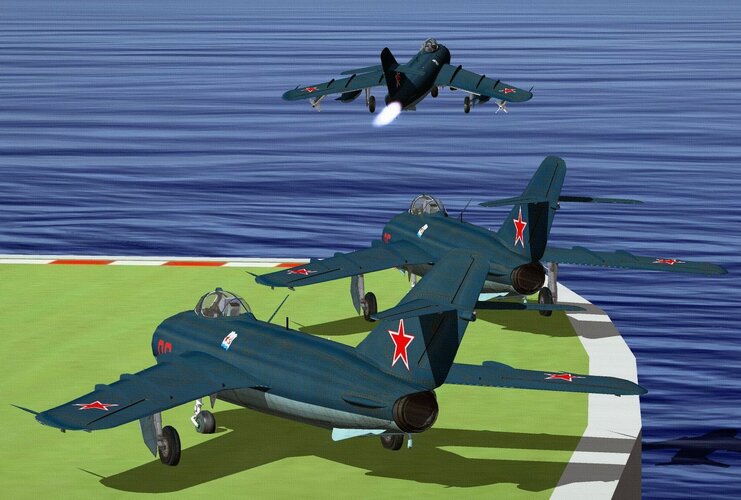
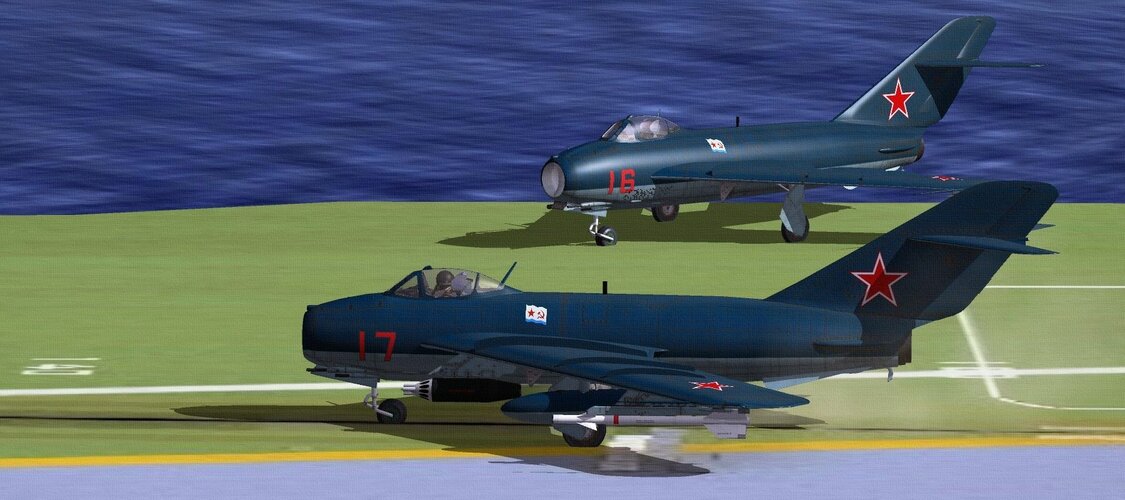
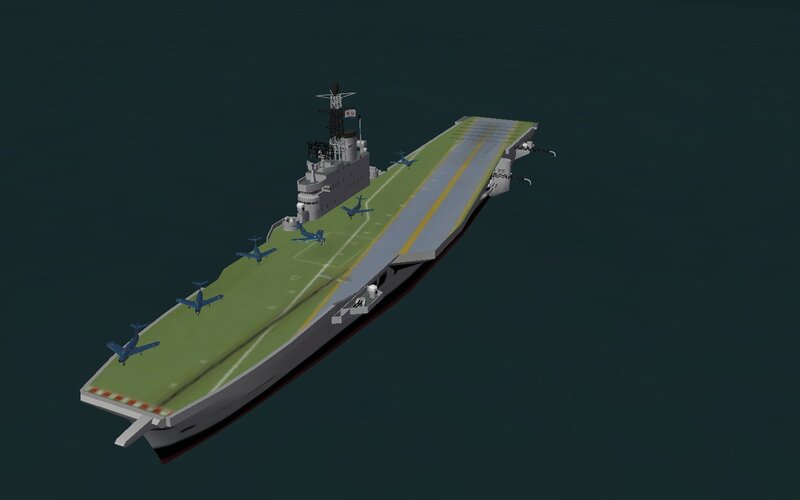
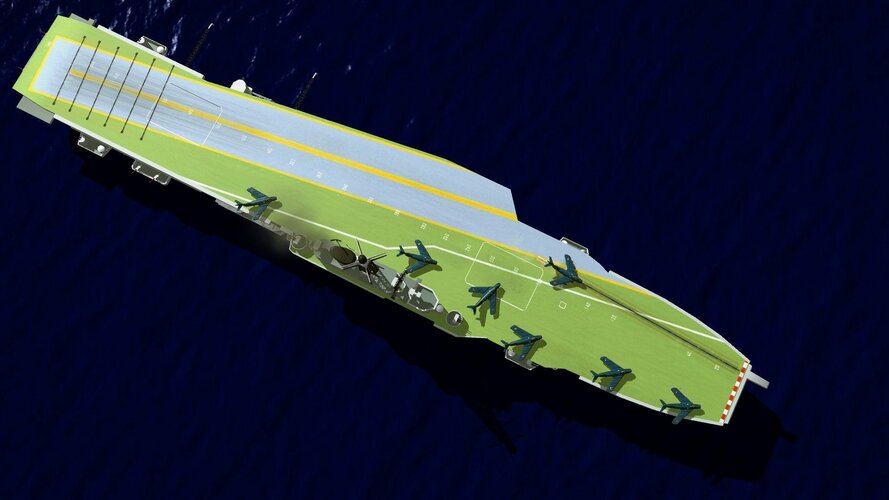
Last edited:
F.L.
ACCESS: Top Secret
Another country that could have acquired one or more Colossus/Majestic is Germany.
In the event of conflict with the USSR, protecting the Atlantic convoys would have been vital. I think it's realistic that the German navy should be able to protect them as early as 1957.
The air groups would probably have consisted of Sea Hawk Mk.100s; then perhaps later of a navalized version of the Fiat G.91 "Gina".
And also ASW aircrafts, Fairey Gannets and peharps later Alizé or S-2 Trackers.



In the event of conflict with the USSR, protecting the Atlantic convoys would have been vital. I think it's realistic that the German navy should be able to protect them as early as 1957.
The air groups would probably have consisted of Sea Hawk Mk.100s; then perhaps later of a navalized version of the Fiat G.91 "Gina".
And also ASW aircrafts, Fairey Gannets and peharps later Alizé or S-2 Trackers.
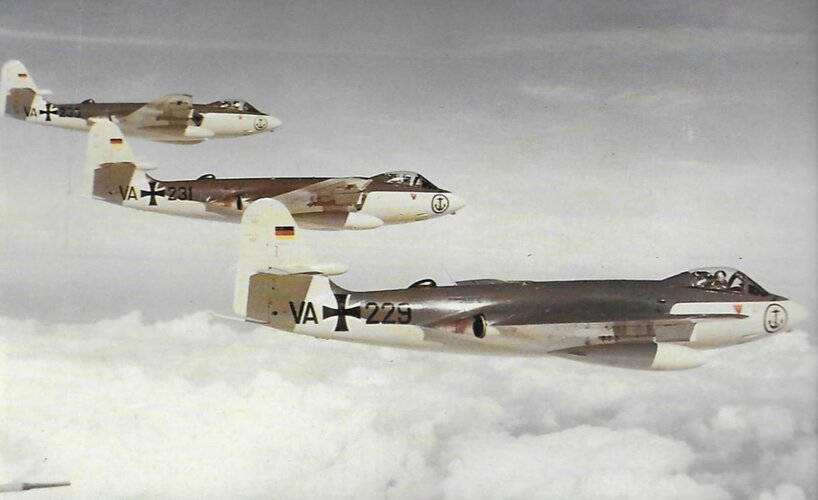
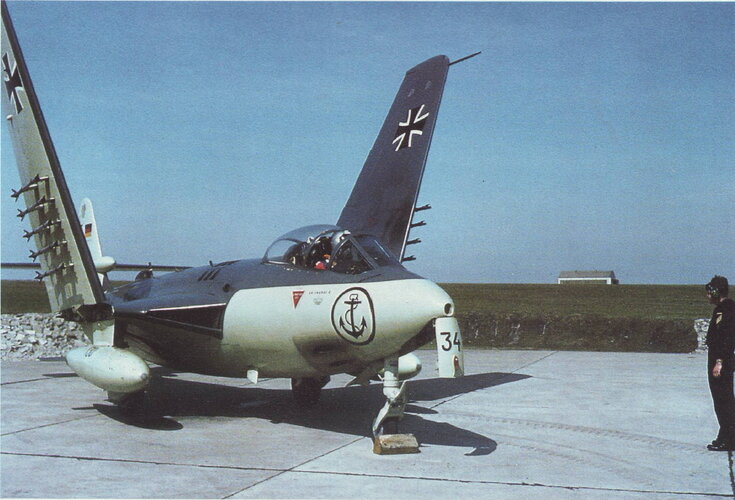
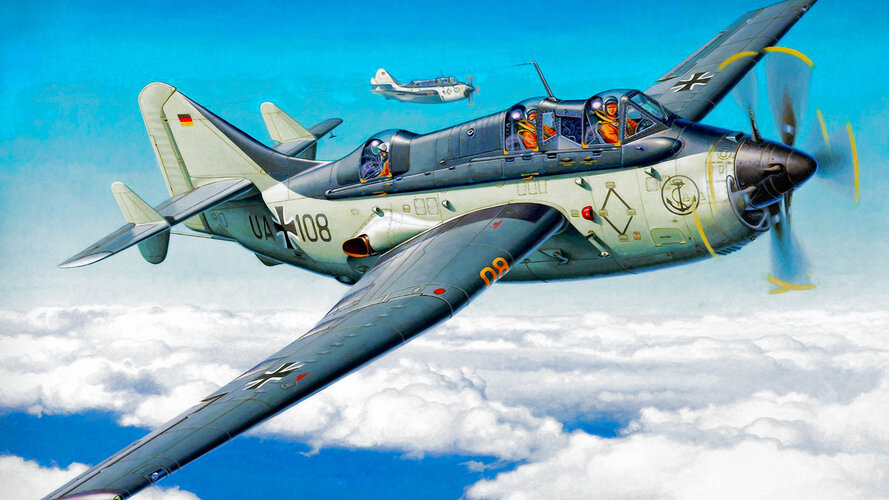
kaiserd
I really should change my personal text
- Joined
- 25 October 2013
- Messages
- 1,665
- Reaction score
- 1,614
One country that could have had Colossus/Magestic is the USSR, in 1944/45.
I think it's a great idea, and realistic, if aircraft carriers are bought early enough.
A "Combat Ace" forum member wrote this what-if story :
In 1946 the UK had a lot of major problems. It suffered high losses during WW2 and war damages all over the country were significant. The industry layed down and a lot of war depts pressed the economy further. On the other hand the Royal Navy had a lot of ships which were not neccessary anymore. So it was decided to sell some major ships, including aircraft carriers. So the HMS Colossus was sold to France, the HMS Warrior went to Canada. The Netherlands wanted to buy the Venerable and Australia was interessted in the Vengance.
1946 the Soviet Union showed their wish to buy 3 carriers of the Colossus class and offered a price of 50tons of fine gold. So the last 3 carriers of the Colossus class, the Theseus, Triumph and Perseus were handed over to the Soviet Sea War Fleet and became the names TAKR Odessa, TAKR Kronstadt and TAKR Sewastopol.
Odessa and Kronstadt were operated by the Northern Fleet, while the Sewastopol was operated by the Baltic fleet for 6 years. In 1952 all carriers were sent back to Navy wharfs to refit them with an angle deck. the blueprints of this innovative design was stolen by the Cambridge Five. In 1955 the Odessa became operational again The Kronstadt followed one year later and the Sewastopol reentered the service in 1957. All 3 carriers were used till mid 70th.
After refit with angle deck the MiG-17 became the core of the Odessa flight group. The MiG-17K was developed from the MiG-17F and was used for daylight operations and in the air to ground role. For bad weather and night operations the MiG-17KP was developed from the MiG-17PF. In 1967 both types were updated to carry the AA-2 Atoll (R-3S) missile.
View attachment 718631View attachment 718630View attachment 718629View attachment 718632
Sorry, but this suggestion is completely, ludicrously, unrealistic.
F.L.
ACCESS: Top Secret
And why, the Americans had indeed considered selling them a few escort aircraft carriers.Sorry, but this suggestion is completely, ludicrously, unrealistic.
The Colossus was sold to France as early as 1946, so it seems possible that the Soviet could have obtained at least one at the same time.
In any case, the British gave them the Rolls-Royce Nene around the same period !
Last edited:
Colossus was loaned to France in 1946 with the transfer taking place on 5 Aug. It was 1951 before the French purchased her.
Britain needed all the Colossus in the early postwar period as they demanded less crew when compared to the Illustrious/Implacables.
Theseus & Triumph were active in the RN in this period so not surplus to requirements. Perseus had been converted to an aircraft maintenance ship before completion in Oct 1945 and didn’t arrive back in the U.K. until May 1946. As such she had no catapult, no arrester gear, cranes and structures built on the flight deck and much of her hangar space filled with workshops.
Britain needed all the Colossus in the early postwar period as they demanded less crew when compared to the Illustrious/Implacables.
Theseus & Triumph were active in the RN in this period so not surplus to requirements. Perseus had been converted to an aircraft maintenance ship before completion in Oct 1945 and didn’t arrive back in the U.K. until May 1946. As such she had no catapult, no arrester gear, cranes and structures built on the flight deck and much of her hangar space filled with workshops.
kaiserd
I really should change my personal text
- Joined
- 25 October 2013
- Messages
- 1,665
- Reaction score
- 1,614
And why, the Americans had indeed considered selling them a few escort aircraft carriers.
The Colossus was sold to France as early as 1946, so it seems possible that the Soviet could have obtained at least one at the same time.
In any case, the British gave them the Rolls-Royce Nene around the same period !
Does it really need to be explained why gifting the UK a light fleet carrier to the French in 1946 is radically different to the UK gifting the USSR such a carrier in the same period or later?
In the same time period Western Navies (very much including the Royal Navy) were already significantly worried by the USSRs Sverdlov cruisers and their potential use as commerce raiders. In what vaguely likely scenario does the UK also give the USSR carriers to provide support to these cruisers or otherwise operate to their detriment?
The comparison with the actual sale of Nene engines is misguided. That was due to the UK authorities of the time seeing centrifugal turbojet engines as essentially obsolescent jet engine technology outclassed by their latest more advanced engines (like the Avon). That decision was very flawed and had a major impact on Soviet aviation. However in fairness to those UK authorities weren’t completely wrong in that centrifuge turbojet engines didn’t have that much scope for development and the USSR hit a bit of a brick wall with them that ended up hampering Soviet aviation development until they developed and fielded their own advanced axial flow turbojet engines. A very different scenario to selling carriers to greatly strengthening your only Naval threat.
And how would the USSR realistically sustain the operation of such carriers if all the carriers equipment was British made (engines, catapults etc)?
Scott Kenny
ACCESS: Above Top Secret
- Joined
- 15 May 2023
- Messages
- 5,850
- Reaction score
- 4,610
Oh, I may have a modeling project...Yes I mean them.
This is history: during 1950 a first group of Italian Naval aviators were sent to Pensacola to start training, and they in 1952 were able to fly Naval aircraft as US NAVY personell, including carrier operations. Italian Navy was provided by US counterpart of about 50 Curtiss S2C-5 Helldiver, to be placed onboard the first Italian carrier in anti-submarine role.
The very first two of them left the USS Midway, cruising in the Mediterranean Sea, the 12th of December 1952 to Naples Naval Air Station. They were designated: Italian Navy Gull One (101) and Gull Two (102) and they were painted with typical US NAVY midnight blue with Italian roundels with an anchor atop. Once landed in Capodichino airport they were immediately surrounded by Italian Military Police (Carabinieri) since the crew was not recognized by Italian Law (not real Mussolini's one rather than Balbo driven) as Italian airmen rather than "pirates"!!!!
The embarassing situation was temporarily resolved taking both aricrafts and their crews within the margin of American part of Capodichino airport (that still exists today).
At the end, as we all know, the Italian Air Force won: the navy never got its CVLs and the Helldivers were placed under Air Force rules. The S2C had a brief anti-submarine career with the Air Force and was replaced by Grumman Trackers and the end of 50's.
View attachment 650496
View attachment 650495
View attachment 650501
View attachment 650497
View attachment 650498
Italian politics in a nutshell.Gosh, this is more akin to Comedia del arte, than astronautics. WTH.
Se non è vero, è ben trovato
Which Iranian pilot is crazy enough to try to land one of their Tomcats on that postage stamp of a carrier?Or even pre revolutionary Iran simply because they had the money.
That's probably ideal.I recall reading somewhere that the RN, at one point at least, saw the 1942 CVLs as replacements for the station cruiser squadrons. Presumably accompanied by at least one cruiser and a number of destroyers and or frigates, they would provide the global presence and commerce protection once provided by cruisers.
Not to mention pretty much how the US operates carrier groups today!
Instead of a cruiser squadron, you have a carrier group. The whole group goes together.Though on service the carrier wouldn't able to operate truly independently, for example it would likely often require at least an existing cruiser as part of it's escort or else a larger number of lighter escorts. It would overall use up or tie down more resources in the long term than a good cruiser.
And it's a lot more capable of projecting power if you have to start dropping bombs on idiots.
No. Germany was banned from operating carriers until the 1980s at least.Another country that could have acquired one or more Colossus/Majestic is Germany.
In the event of conflict with the USSR, protecting the Atlantic convoys would have been vital. I think it's realistic that the German navy should be able to protect them as early as 1957.
The air groups would probably have consisted of Sea Hawk Mk.100s; then perhaps later of a navalized version of the Fiat G.91 "Gina".
And also ASW aircrafts, Fairey Gannets and peharps later Alizé or S-2 Trackers.
View attachment 718634View attachment 718635
View attachment 718653
And their Navy was focused on the Baltic, not the North Atlantic.
F.L.
ACCESS: Top Secret
Was there a law prohibiting Germany from having an aircraft carrier ?No. Germany was banned from operating carriers until the 1980s at least.
I find it extraordinary that the German navy had the resources to set up a carrier-group (Sea Hawk, Gannet) but no aircraft carrier !
Scott Kenny
ACCESS: Above Top Secret
- Joined
- 15 May 2023
- Messages
- 5,850
- Reaction score
- 4,610
Pretty sure that was part of the surrender treaty from 1945.Was there a law prohibiting Germany from having an aircraft carrier ?
I find it extraordinary that the German navy had the resources to set up a carrier-group (Sea Hawk, Gannet) but no aircraft carrier !
- Joined
- 27 September 2006
- Messages
- 5,744
- Reaction score
- 5,615
The postwar German forces were permitted under the Western European Union (WEU) Treaty which preceded NATO. This restricted the Bundesmarine to ships below a certain tonnage, ruling out carriers.
F.L.
ACCESS: Top Secret
Could Soviet submarines have posed enough of a threat for this restriction to be lifted ?The postwar German forces were permitted under the Western European Union (WEU) Treaty which preceded NATO. This restricted the Bundesmarine to ships below a certain tonnage, ruling out carriers.
Such vessels would, of course, have been intended primarily for anti-submarine warfare.
- Joined
- 27 September 2006
- Messages
- 5,744
- Reaction score
- 5,615
Not really as the Bundesmarine bought Atlantique ASW and Seaking helos plus three ASROC equipped C F Adams class destroyers in the 60s followed by a class of frigates with Lynx in the 70s.
An elderly British carrier would not have fitted in. The Seahawks were replaced by Starfighters and then Tornados with ASM.
Ironically the post unification FRG did briefly consider a helicopter carrying support ship for out of area ops but dropped the idea in favour of big replenishment ships
An elderly British carrier would not have fitted in. The Seahawks were replaced by Starfighters and then Tornados with ASM.
Ironically the post unification FRG did briefly consider a helicopter carrying support ship for out of area ops but dropped the idea in favour of big replenishment ships
SSgtC
ACCESS: Top Secret
- Joined
- 13 July 2020
- Messages
- 1,126
- Reaction score
- 2,527
In addition to what @uk 75 said, the primary area of operations for the German Navy in any hypothetical WWIII was going to be the western edge of the Baltic Sea and part of the North Sea. Given the geography of the area, a carrier was likely to provide little to no benefit over land based aircraft.Could Soviet submarines have posed enough of a threat for this restriction to be lifted ?
Such vessels would, of course, have been intended primarily for anti-submarine warfare.
The Breguet 1150 Atlantic 1, as bought by Germany, had an helluva long range or endurance: perhaps France longest ranged production aircraft ever. That thing could fly 14 to 19 hours !
Unlike a Nimrod it had turboprops, but unlike an Orion (or its Soviet look alike) it only had 2 rather than 4 engines. Plus it had been specifically build as a MARPAT, unlike all the others: modified airliners.
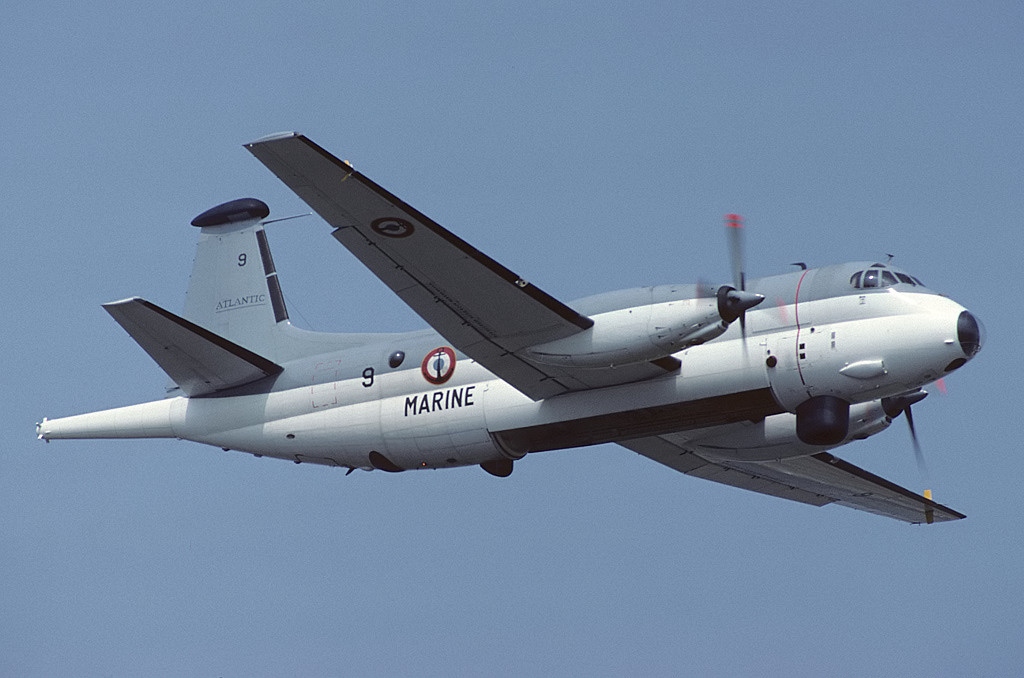
 en.wikipedia.org
en.wikipedia.org
Unlike a Nimrod it had turboprops, but unlike an Orion (or its Soviet look alike) it only had 2 rather than 4 engines. Plus it had been specifically build as a MARPAT, unlike all the others: modified airliners.

Bréguet 1150 Atlantic - Wikipedia
Lascaris
ACCESS: Secret
- Joined
- 14 November 2008
- Messages
- 271
- Reaction score
- 312
Not pertaining to our world but my Lost Monkeys TL over in alternatehistory.com, so bear with me if it's the wrong thread, but how useful would be a Majestic or an Independence/Saipan if you are TTL Greece (which can afford one) and you are trying to protect convoys to Cyprus?
I suppose that you can use a Majestic either as an ASW carrier with Trackers/Alizes/Gannets or to supplement air cover flying N-156F. Is it actually good value for money or painting a huge target sign on it because the admirals want a big ship? Rather less certain.
I suppose that you can use a Majestic either as an ASW carrier with Trackers/Alizes/Gannets or to supplement air cover flying N-156F. Is it actually good value for money or painting a huge target sign on it because the admirals want a big ship? Rather less certain.
SSgtC
ACCESS: Top Secret
- Joined
- 13 July 2020
- Messages
- 1,126
- Reaction score
- 2,527
My gut says, not very. It's only 550 miles or so from Greece to Cyprus. With aircraft based in both places, they can provide air cover without the expense of, or the risk of losing, a carrier. You'd be better off flying Neptunes with fighter escorts than trying to use a carrier in such a restricted areaNot pertaining to our world but my Lost Monkeys TL over in alternatehistory.com, so bear with me if it's the wrong thread, but how useful would be a Majestic or an Independence/Saipan if you are TTL Greece (which can afford one) and you are trying to protect convoys to Cyprus?
I suppose that you can use a Majestic either as an ASW carrier with Trackers/Alizes/Gannets or to supplement air cover flying N-156F. Is it actually good value for money or painting a huge target sign on it because the admirals want a big ship? Rather less certain.
Similar threads
-
Less Independance-class, more Saipan carriers, to foreign navies postwar.
- Started by Archibald
- Replies: 5
-
Jean Bart battleship turned aircraft carrier (1942 - 1992)
- Started by Archibald
- Replies: 4
